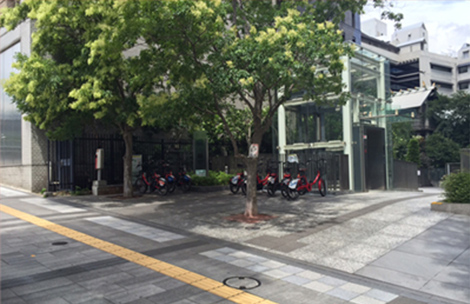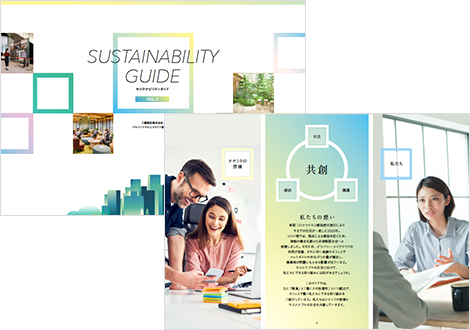We are engaged in medium- to long-term investment and management of office buildings, made possible by building positive relationships with stakeholders and various community-related initiatives.
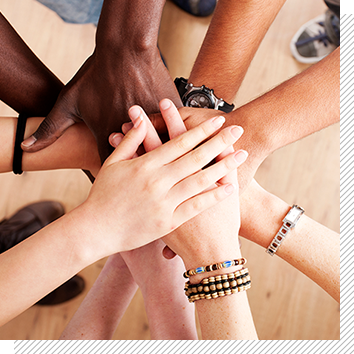
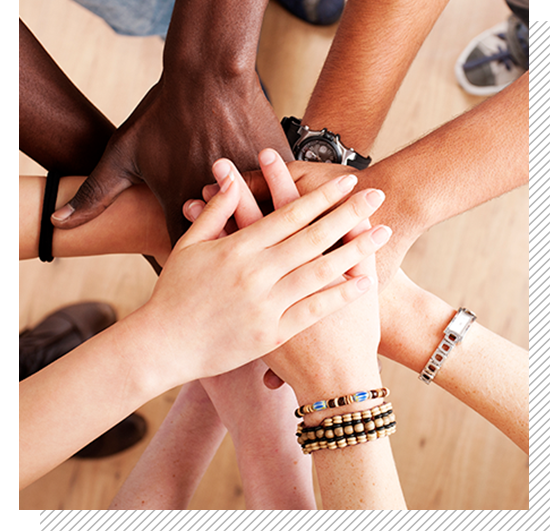
Social Impact Real Estate
What is Social Impact Real Estate?
The Ministry of Land, Infrastructure, Transport and Tourism, in its "Practical Guidance on 'Social Impact Real Estate'" published in March 2023, defined such real estate as "Expected to make significant 'social impact' by contributing to resolving various issues surrounding people, regions (surrounding land and community), and the planet (global environment), and to contribute to creating value for society, including the conservation of the global environment, and to increase the value of real estate and promote sustainable growth of companies".
'Social impact' refers to those effects which have a social significance that arises as a result of an initiative.
JRE undertakes various initiatives related to "social impact real estate". Our goal is to improve societal value and address social issues through real estate, whilst aiming to realize ‘offices of tenants' choice’.
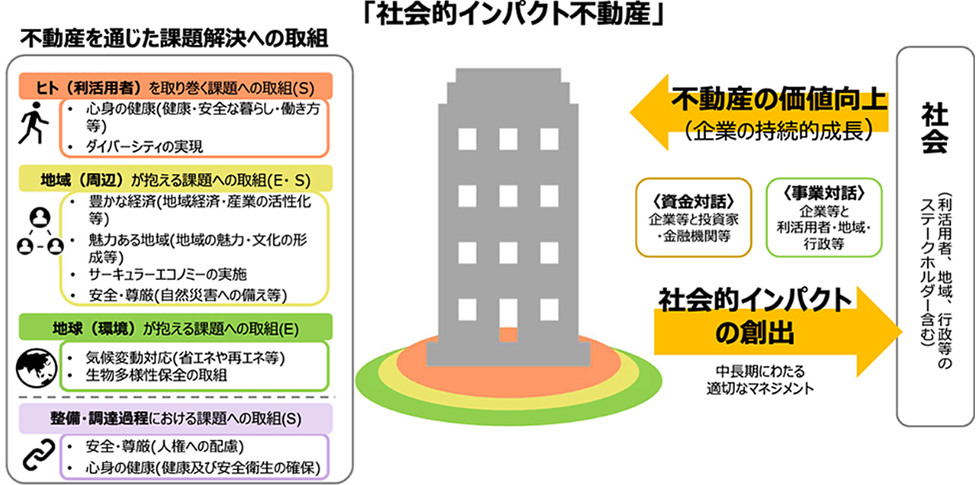
Source: Ministry of Land, Infrastructure, Transport and Tourism's "Practical Guidance on ‘Social Impact Real Estate’" (March 2023) (available only in Japanese)
Classification of Social Issues Related to Real Estate (4 Stages, 14 Issues)
The “Practical Guidance on ‘Social Impact Real Estate’” , published by the Ministry of Land, Infrastructure, Transport and Tourism, organizes social issues to address through real estate into 4 stages / 14 issues. In accordance with this classification, JRE organized and disclosed initiatives (activities) and social impact at JRE and JRE-owned properties.
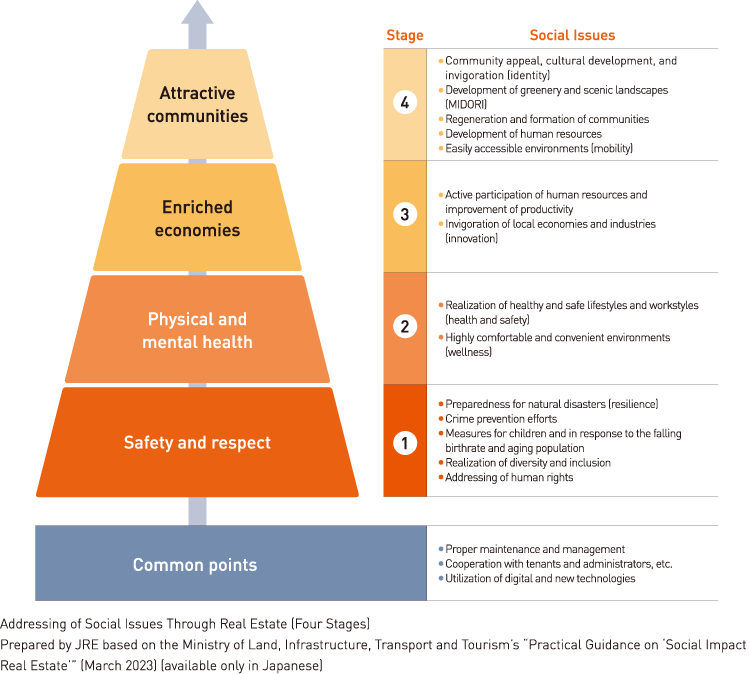
Social Impact Real Estate Initiatives Undertaken by JRE
Otemachi Park Building
| Initiatives / Activity | Creating a space that embraces both the biodiversity of the "Hotoria Square" environment and the activities of visitors and office workers in totality |
|
|---|---|---|
| Social issues to be addressed | ② Physical and mental health |
|
| ④ Attractive communities |
|
|


The "Hotoria Square," an open space connecting the premises of Otemon Tower ENEOS Building and Otemachi Park Building, which face the Imperial Palace Outer Garden, has been beautified in 2024 using the Ministry of Land, Infrastructure, Transport and Tourism's Public Green Space Accreditation System, with the installation of benches and the maintenance of plantings. Respecting both the historical landscape of Otemachi and the natural environment of the Imperial Palace Outer Garden, we designed an attractive "Hotoria Square" based on logical directions derived from deciphering historical surveys and ecological surveys, while taking a total perspective of both efforts to nurture biodiversity and the activities of visitors and office workers. This time, by adding more benches, additional plantings, and maintaining wall greening, we have expanded our commitment to creating spaces for further community interaction.
Moreover, we have been putting into practice community exchanges aimed at environmental coexistence, such as actively adopting participatory efforts to maintain the living environment of creatures and the development of facilities that contribute to the purification of water quality in the Imperial Palace Outer Garden moat. We are conducting new attempts using urban spaces rooted in Japan's traditional public mindset.
JRE Kanda-Ogawamachi Building
| Initiatives / Activity | Creating a comfortable and convenient environment for tenant employees | |
|---|---|---|
| Social issues to be addressed | ② Physical and mental health |
|
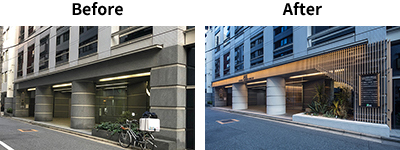


At JRE Kanda-Ogawamachi Building, we've renewed our entrance with warm, natural wood materials. Additionally, the restroom faucets have all been replaced from the old ones, yielding water-saving effects of more than 40% (compared October 2024 and October 2023). In terms of the shared tenant areas, we’ve designed with user comfort in mind, increasing safety with touchless devices and antivirus materials, promoting wellness amongst our tenant’s employees. After the renovation, we've received a lot of comments from the tenants saying things like "The building's atmosphere has drastically changed, making it more comfortable to work in".
JRE Tenjin 3Chome Building
| Initiatives / Activity | Initiatives aimed at improving the health and comfort of tenant employees through the complete removal of communal smoking rooms | |
|---|---|---|
| Social issues to be addressed | ② Physical and mental health |
|
At JRE Tenjin 3Chome Building, with the Health Promotion Act as an opportunity, the common smoking areas installed next to the elevators on floors 2 to 8 were completely removed. With the elimination of smoke and cigarette smell that tends to emerge from and around these rooms, a cleaner and more comfortable office environment has been provided, and thus has improved the working conditions for building's tenant employees. Furthermore, in an environment without a smoking area, opportunities to smoke decrease. This could serve as an opportunity for smokers to consider quitting, leading ultimately to the health and comfort enhancement of tenant employees.
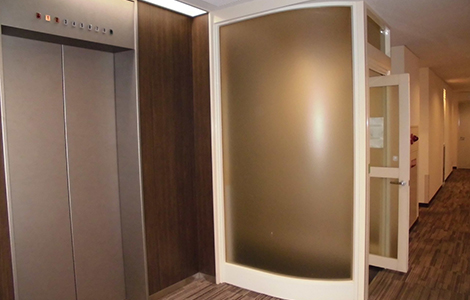
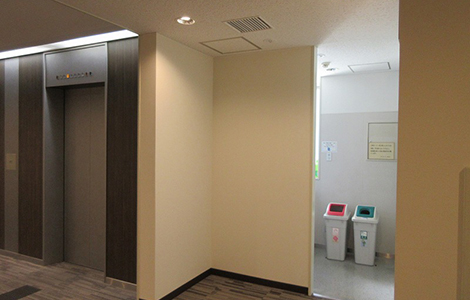
MM Park Building
| Initiatives / Activity | Efforts for waste recycling and a circular economy through the use of reused furniture | |
|---|---|---|
| Social issues to be addressed | Common points |
|
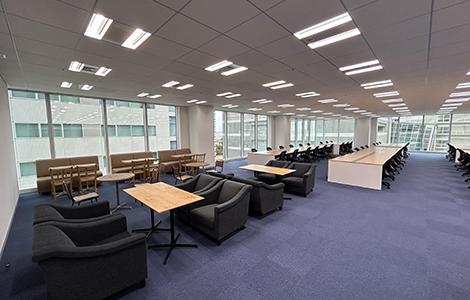
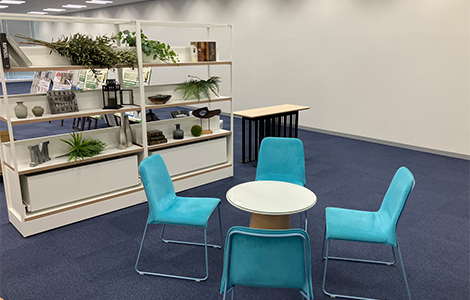
At MM Park Building, we set up used furniture arranged by Eco-furni in the entrance and vacant sections to create ready-to-use offices that support our leasing activities. This initiative, which meets customer companies' needs for a high-quality office space at a reasonable price by providing reused items instead of new ones, also contributes to the realization of a society that does not waste things, a circular economy, and waste-reduction activities.
What is Eco-furni?
'Eco-furni' is a business that collects and sells used furniture. It is a service born out of the 'New Business Proposal System', which gathers business proposals and ideas from a wide range of employees from the Mitsubishi Estates Group. Witnessing how many pieces of still usable office furniture were inevitably thrown away due to office layout changes, employees conceptualized this service as a solution for office tenants and an effective utilization of resources, thereby planning, proposing, and eventually launching the project. Please click here about the details of Eco-furni. (available only in Japanese)

- Collects unnecessary office furniture from companies due to layout changes, etc., directly inspects and cleans at the showroom-cum-warehouse, and exhibits and sells it as reused furniture.
- Prioritizes reusing office furniture to reduce recycling and disposal.
- A service that satisfies both economic and environmental values.
- Considers the environmental load accompanying transportation by achieving as much local circulation as possible.
- Can be utilized as a 'setup office' that rents with furniture set in the office, and a subscription service for furniture and home appliances.
Kanazawa Park Building
| Initiatives / Activity | Creating a comfortable and convenient environment for tenant employees | |
|---|---|---|
| Social issues to be addressed | ② Physical and mental health |
|
| ③ Enriched economies |
|
|
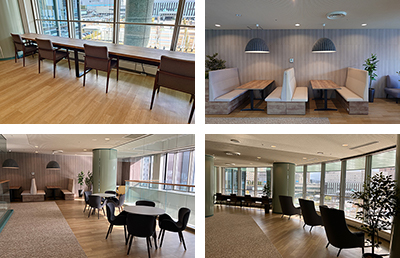
At the Kanazawa Park Building, we have renovated the fourth-floor lobby to provide a space where tenant employees can hold meetings, work, and eat, thereby supporting varying working style of the tenant employees. Before, we have placed items in the lobby such as sofas, tables and chairs for visitors to use while waiting, however, we have newly introduced things such as desks with power outlets and single-seater sofas to make the space more comfortable. After the renovation, there have been many comments from tenant companies remarking that "the open atrium lobby has become an even more comfortable space, enhancing the wellness of our employees and leading to improved productivity". Furthermore, the number of situations where it is actively used when guests visit has increased, and it is utilized as a comfortable space even for business discussions with customers. Many tenants from floors other than the fourth have been expressing their preference for similar renovations.
Kanazawa Park Building
| Initiatives / Activity | Formation and revitalization of local appeal and culture, regeneration and formation of communities, realization of diversity and inclusivity | |
|---|---|---|
| Social issues to be addressed | ① Safety and respect |
|
| ④ Attractive communities |
|
|
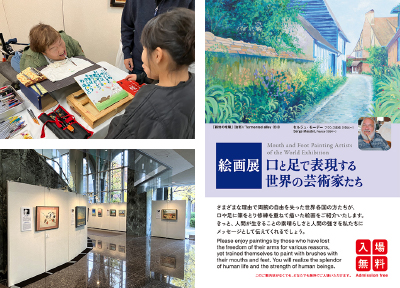
At Kanazawa Park Building, the tenants hosted an art exhibition in the entrance hall on the first and second floors and the second floor meeting room, based on the theme of ‘Artists of the World Expressing with Mouths and Feet held in November 2024.’ The event introduced paintings created by painters from around the world who have lost the freedom of both arms for various reasons and who have repeatedly trained to paint with brushes in their mouths or feet. On the day, approximately 50 works by domestic and international artists with hand disabilities were displayed. JRE hopes to serve as a bridge between those who appreciate this event and those with disabilities through this event in the building. Visitors have said, "It's a wonderful event, and we hope you continue to use the entrance for these kinds of events in the future," and "We would like to use the first-floor entrance hall for events we plan ourselves." Also, this event has contributed to the revitalization of the community.
Toyosu Foresia
| Initiatives / Activity | Emergency meal service at disaster sites using food trucks, operated by the General Incorporated Association Food Truck Response Team | |
|---|---|---|
| Social issues to be addressed | ① Safety and respect |
|
| ④ Attractive communities |
|
|
At Toyosu Foresia, we aim to support workers during disasters by securing space on the premises, allowing a group of food trucks to dynamically set up and supply meals.
This group, which we refer to as the Food Truck Response Team, is a general incorporated association formed by 'Mellow Inc.' that currently operate at Toyosu Foresia, and other food truck operators. They have signed agreements with various cities and towns to supply meals during disasters. During a disaster, it is expected that there would be challenges such as power, water, and gas outages, leading to a continued depreciation of available meals. Despite this, we have prepared to provide warm and delicious meals through these food trucks, solving issues of food shortage and improving the quality of meals during disasters.
Stakeholder Engagement
Sustainability Program for Tenants
JRE is implementing various initiatives to increase the satisfaction and enhance the sustainability of tenants in each building.
Sustainability Guide to Promote Owner and Tenant Collaboration
JRE creates and distributes the Sustainability Guide as part of its efforts to promote collaboration with tenants. The Sustainability Guide introduces activities that we can do in the office, mainly from the viewpoints of the “environment” and “tenant well-being.”
For details on sustainability guide, please visit the link below.
| Date Published | Theme |
|---|---|
| September 2019 | Work Style Reform |
| April 2021 |
Offices in the “New Normal” Era Waste Recycling |
| March 2025 |
Commitment to Sustainability What You Can Do Now Waste Separation (available only in Japanese) |
Intoroduction of Green Leases
JRE is promoting the incorporation of green lease clauses into lease agreements in order to collaborate with tenants in reducing environmental impact.
For more details, please refer to the related information.
Survey on Tenant Satisfaction
We carry out satisfaction surveys to achieve a high level of customer satisfaction and realize sustainable buildings.
Feedback of Environmental Data / Online Tenant Services
We provide feedback to tenants including energy, water usage, and waste-related data. In addition, we provide online feedback and services using our proprietary system.

Feedback on Sustainability to PMs
JRE conducts surveys for PMs for all properties in the portfolio based on the GRESB-related questions, a global real estate sustainability certification. Based on the survey results, we analyze sustainability efforts at each asset level.
As for the survey results and each property’s sustainability efforts, we provide PM companies with opportunities to provide feedback.
We believe that property managers who are connected with tenants and visitors to each building will improve the level of sustainability of our entire portfolio by raising their sustainability-related knowledge and awareness.
ESG Seminars for Stakeholders
JRE offers ESG seminars for our business partners, master lessees, and property managers, among others, for the purpose of raising stakeholder awareness. We invite ESG experts from outside the Company to cover global ESG trends and discuss specialized fields such as GRESB and ZEB.
We believe that raising sustainability awareness not only within JRE, but among all our stakeholders, will benefit sustainability efforts at each asset level.
Improving Tenant Satisfaction
Tenant satisfaction survey
JRE regularly conducts tenant satisfaction surveys aiming to improve operation and management of the buildings.
(Example) Survey on the level of satisfaction with the building and its operation
In a bid to increase the asset value, JRE conducted the renovation work for common areas in JRE Shiba 2Chome Daimon Building, including switching from central to individual air conditioning systems and upgrading them to more energy‐saving ones, converting to LED lights in the building, and installing card access security systems, which led to increased satisfaction of its tenants in a survey on how they are satisfied with the building and its management.

Initiatives for the safety and health of tenants
JRE has been proactively implementing measures for the safety and health of tenants.
(Examples)
- Formulation of the earthquake damage identification criteria
- Introduction of an earthquake damage identification system/tool
- Establishment of a system to check and share information about the damage caused by earthquakes
- Establishment of the guidelines on evacuation judgment
- Establishment of the guidelines on actions to be taken for stranded commuters in the event of disaster(Akasaka Park Building, Kitanomaru Square, Yurakucho Denki Building)
- Organization of a disaster control council and implementation of disaster control and firefighting drills
- Implementation of indoor air quality measurement and pest control for tenant spaces (100% portfolio coverage)
- Installation of automated external defibrillators (AEDs)
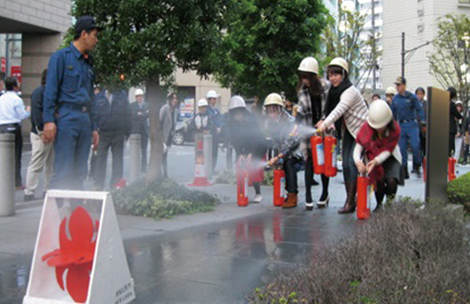
(Note) In principle, all properties are subject to conducting the initiatives, unless otherwise stated (excluding certain co-owned properties, etc.).
Relationship with Local Communities
JRE has been participating in a range of activities to contribute to local communities and local society. We also foster mutual communication with various stakeholders, including local authorities, local residents, and visitors of our facilities, through such activities.
Contribution to community development
JRE addresses issues related to community development, including urban redevelopment and revitalization as part of investing in and operating office buildings located in major cities throughout Japan. JRE works to improve the long-term value of its portfolio by contributing to the sustainable development of cities through cooperation with local stakeholders, including local governments, regional councils, tenants, and our sponsor that is a developer.
GRAND FRONT OSAKA - Urban revitalization / urban redevelopment project
GRAND FRONT OSAKA which JRE acquired in October 2021 has build a “Knowledge Capital” where knowledge is created. “Knowledge Office Space”, consisting of knowledge work space (for researchers, creators, business owner) and educational functions and “Future Life Showroom” exhibiting new lifestyle delivered by the fusion of advanced technologies and sensibilities are represented. The “Knowledge Plaza” located at the center of the North Wing is a symbol of the “town”. Events and presentations linked to the Knowledge Capital are held here, bringing even more life and vitality to exchanges between people in the city.
Furthermore, as a general incorporated association “Grand Front Osaka TMO” was established to operate the Grand Front Osaka integrated town, a participatory type of “town” development is promoted to grow the “town” along with its residents, workers and visitors, to bring bustle and vitality back to a place people will want to come to every day.
Urban redevelopment project in cooperation with Mitsubishi Estate Co., Ltd.: Link Square Shinjuku
Link Square Shinjuku which is directly connected to the pedestrian deck of Shinjuku Station was completed and opened in 2019 and has become a bustling hub connecting Shinjuku, Yoyogi and Sendagaya area. Along with the disposal of the building of the former Nippon Brunswick Building, for which 39 years already had passed since the completion of the property at the time of the disposition in August, 2013, JRE established a fixed-term land leasehold agreement with Mitsubishi Estate Co., Ltd. and the large-scale redevelopment project has been conducted. The subsequent project removed the old three buildings along Meiji street which did not fit the new earthquake resistance standards and constructed a new one strengthening the community disaster preparedness function with a 16 story complex consisting of offices, commercial facilities, and community contribution facilities, etc., which has greatly enhanced the attractiveness of the area. For details, please refer to the press release.(available only in Japanese)
AER - Urban redevelopment and opening of the Miyagino Bridge
AER located on the north side of Sendai Station was developed as part of the Urban Redevelopment Project (Category 2) for the 1st South District to the North of Sendai Station and completed and opened in 1998. Along with the redevelopment of this area, rebuilding of the Miyagino Bridge (Motoderakoji-Fukumuro Road) connecting the east and west of the area in the north of Sendai Station was planned.
The Miyagino Bridge that had been long awaited for by local residents was opened in March 2017. JRE also cooperated in opening events, such as the “Watarizome (first crossing ceremony) of the Miyagino Bridge”.
JRE Aoyama Crystal Building - Contribution to community development
In the Kita-Aoyama district where the JRE Aoyama Crystal Building is located, redevelopment is underway at the adjacent former site of the Tokyo Metropolitan Aoyama-Kitamachi Apartments over an area of approximately four hectares.
The objectives of this project are to “rebuild municipal housing through conversion into a higher building and consolidation while establishing a nursery school and children’s facilities in the lower floors and developing a children’s playground. In addition, the land created from the apartment redesign will be utilized for the purpose of promoting an integrated community building along Aoyama Street and forming a cutting-edge base for spreading culture and fashion that brings together the abundant activity, culture, and greenery in the area. In addition, area management will be conducted to maintain a lively and favorable environment and to improve the value of the community.”
JRE-AM contributes to the local community through participation in the Aoyama Community Development Council as a member of the community, and participation in discussions regarding matters such as the establishment of community development guidelines for the area around Aoyama Street.
Strategy to attract tenants aimed at urban revitalization
For properties owned in Tokyo area, we have adopted a strategy to attract tenants that will help to make the city more attractive and revitalize the region based on the Urban Development System Utilization Policy for New City Development of the Tokyo Metropolitan Government.
At TIXTOWER UENO, stores in line with the characteristics of the area were invited to foster a downtown bustling atmosphere while preserving the original mood of the area. Also, tenants engaged in the education business were invited to enhance an urban function that is highly convenient for the local community.
At Shiodome Building, an industry support facility called Private Office Zone was established to assist the development of new industries and businesses that will be innovators for the next generation. The area was designed to serve small office needs. A tenant engaged in the serviced office business that can provide office support services and flexible lease terms was invited.
In addition to the above, JRE participates in the committees on landscape planning organized by Shinagawa ward, the Minato Mirai 21 Urban Development Council, the Osaka Diamond City Association, and the Kanazawa City Ekinishi Development Council, and fosters interactions with local communities through these activities.
Local contribution in the event of a disaster
For Akasaka Park Building and others, we have established a system to host stranded commuters in the event of a disaster, and for Otemachi Financial City we have concluded an agreement with Chiyoda ward to host stranded commuters in such an event. In addition, within the premises of Kanazawa Park Building, we respectively installed a well and a regional warehouse for disaster control. We also participate in disaster controls drills held in Mitsubishi UFJ Trust and Banking Building and other buildings. Through these activities, we strive to contribute to the community by offering place where they can turn to in the event of disaster, thereby contributing to local communities.
Support for local events, local group activities, and artistic and cultural activities
For Shiodome Building, we support a local summer festival by providing the venue, and financial and human resources, while for Osaki Front Tower we support an illumination event at the promenade along the Megurogawa river. Also, we regularly hold local music events in JRE Higashi Nibancho Square and Tokyo Opera City Building at the open spaces and common areas while supporting a range of artistic and cultural activities conducted in Tokyo Opera City Building, which comprises multiple cultural facilities. In this way, JRE has committed to promoting regional revitalization as well as artistic and cultural activities by supporting a range of events.
Separately, we have been contributing to regional revitalization by supporting local group activities, for example for a local and professional football team, Fagiano Okayama, at Lit City Building.
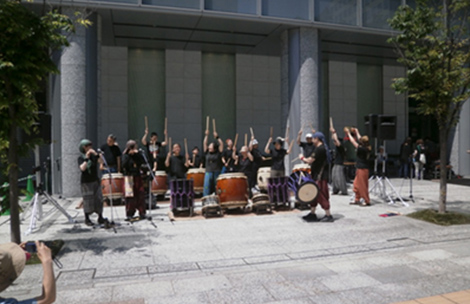
Contribution to the local environment and community health
Akasaka Park Building hosts the "SpoGOMI" event, turning trash pickup into a fun sport. This event brings together tenant companies, the property management company, and the owner to beautify the local environment, promote participants' health, and strengthen community ties. Unlike conventional trash pickup, "SpoGOMI" is a social contribution activity that participants enjoy.

At Kitanomaru Square, we provide the Cycle Port (space for “community cycles”) for shared bicycles, thereby contributing to CO2 emission reductions from the neighboring communities.
Also, within the premises of JRE Shiba 2Chome Daimon Building, we provide a space for the Japanese Red Cross Society to conduct blood donation activities as part of our initiatives to contribute to local medical and health care.
